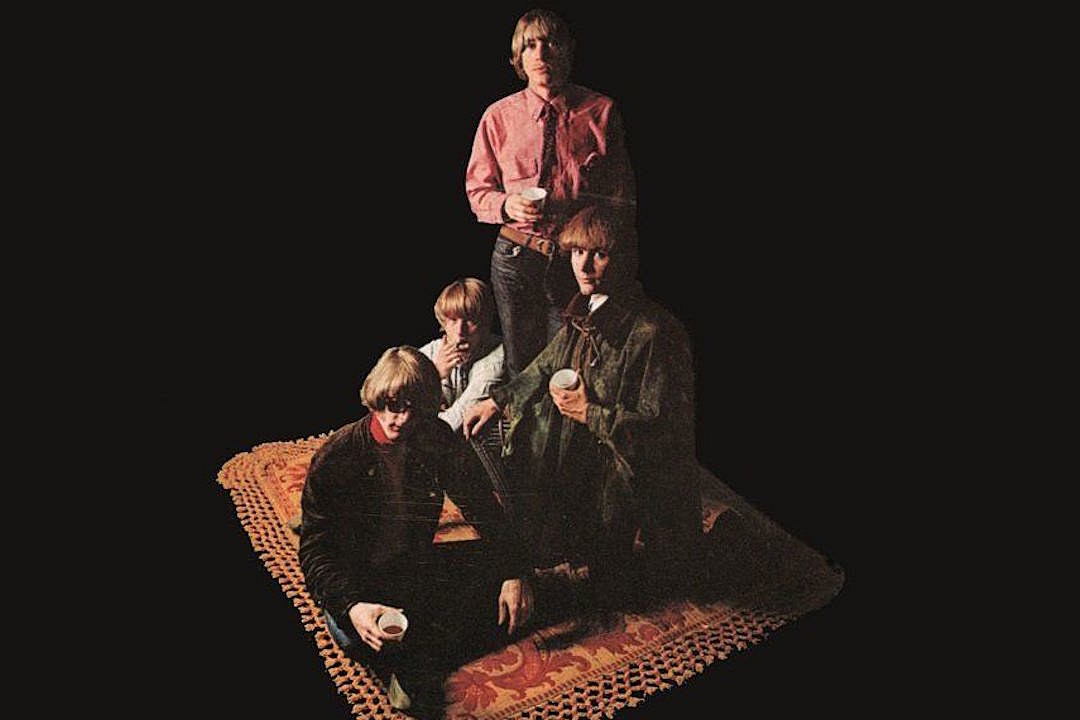
Apparently the band had been listening to a cassette containing music from renowned jazz saxophonist John Coltrane (particularly a 1963 track entitled ‘India’) and Indian sitarist Ravi Shankar on their tour bus and this combination was a heavy influence on the creation of ‘Eight Miles High’ and other tracks on the upcoming 5th Dimension album (released in July 1966), resulting in a sound latterly known as ‘raga-rock’ though Roger (formerly Jim) McGuinn prefers to call it ‘jazz-fusion’ and is adamant that it wasn’t ‘psychedelic’. Their 6th single release in 11 months following the hits ‘Mr Tambourine Man’ (US #1), ‘All I Really Want To Do’ and ‘Turn! Turn! Turn’ (US #1), while ‘Eight Miles High’ features the Byrds familiar jangly guitar sound, some marvellous bass work by Chris Hillman and soaring 3-part harmonies (Crosby, McGuinn and Michael Clarke) it’s opening, closing and middle guitar solos are something else entirely. Most of the basic musical composition of ‘Eight Miles High’ was down to Gene Clark – though McGuinn’s guitar work which propelled the Byrds to new heights of musical sophistication came from remarkably diverse sources.

(This is why I personally believe ‘folk-rock’ was actually invented by the Searchers several months before the Byrds debut) There is also a mention of ‘small faces’ in the lyric, a possible reference to the group of the same name who had their first UK hit when the Byrds were touring the UK. Clark left the Byrds in February 1966 shortly before ‘Eight Miles High’ was released, ironically citing a fear of flying! Crosby added some lyrical lines including couplets referring to their arrival in London, ‘Rain grey town, known for its sound’ which referred to the on-going British musical invasion of the US music scene – a sound that heavily influenced the Byrds in their early years – their jangly guitar sound can also be heard on early Searchers hits including their version of Jackie DeShannon’s ‘When You Walk In The Room’. The title actually related to their recent flight to England which was about six miles high (32,000 feet), though Clark felt that ‘Eight’ had a nicer sound to it, particularly as the Beatles had hit big in the USA the previous year with ‘Eight Days A Week’. Most of the lyric of ‘Eight Miles High’ was by Gene Clark, begun following a November 1965 conversation with the Rolling Stones’ Brian Jones who the Byrds were touring the US with at the time, which helps to negate fellow Byrds member David Crosby’s continued claims that the song was about drugs since he had limited input. The music press didn’t like them – their performances were somewhat lacklustre and they spent ages tuning up onstage – and they came a little too highly recommended, the Beatles having declared them ‘their favourite band’.

Most of the lyrical content of ‘Eight Miles High’ relates to their first trip to England in August 1965, a tour which was fairly disastrous to say the least. The Byrds were of course also much inspired by the Beatles music and their 3-part harmonies (leader Roger McGuinn played a 12-string Rickenbacker guitar like George Harrison – it’s a Rickenbacker strummed chord that opens ‘A Hard Day’s Night’ from 1964) though they weren’t particularly enamoured with England. With ‘Eight Miles High’ the Byrds had certainly evolved dramatically since their recording debut just a year earlier when they allegedly invented folk-rock with their Number 1 cover of Bob Dylan’s ‘Mr Tambourine Man’, a recording that partly inspired Dylan to go electric to the disgust of many of his fans in the process.

In my personal impression this was a landmark recording in the evolution of popular music and should have been a number one record but wasn’t for reasons we’ll be coming back to. Writers Gene Clark, David Crosby & Jim (later Roger) McGuinnĪs a teenage pop fan and avid record buyer in the mid-1960s, this was the first piece of ‘psychedelia’ that I can recall hearing, in the spring of 1966, (at least by a mainstream pop group) and several months before the Beatles Revolver album which contained, as its closing track, John Lennon’s decidedly ‘far-out’ ‘Tomorrow Never Knows’. Recorded at Columbia Studios, Hollywood, 24th & 25th January 1966 “Crosby will always say, ‘Yeah, it’s about drugs, man!’ But it’s not.”


 0 kommentar(er)
0 kommentar(er)
